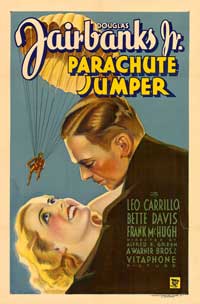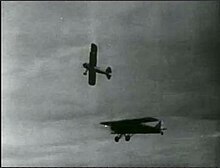Parachute Jumper
| Parachute Jumper | |
|---|---|
 Theatrical release poster | |
| Directed by | Alfred E. Green |
| Screenplay by | John Francis Larkin |
| Based on | an original story by Rian James |
| Produced by | Darryl F. Zanuck (uncredited) |
| Starring | Douglas Fairbanks, Jr. Bette Davis Frank McHugh |
| Cinematography | James Van Trees |
| Edited by | Ray Curtiss |
| Music by | Vitaphone Orchestra conducted by Leo F. Forbstein |
| Distributed by | Warner Bros. Pictures, Inc. |
Release date |
|
Running time | 65 minutes (also listed as 70 and 73 minutes) |
| Country | United States |
| Language | English |
Parachute Jumper is a 1933 American pre-Code black-and-white drama film that was directed by Alfred E. Green. Based on a story by Rian James titled "Some Call It Love", the screen production stars Douglas Fairbanks Jr., Bette Davis and Frank McHugh.[1]
Plot
United States Marine Corps Lieutenants and pilots Bill Keller (Douglas Fairbanks, Jr.) and "Toodles" Cooper (Frank McHugh) are shot down in the skies over Nicaragua. When they are found drunk and unharmed in a cantina, they and the Marine Corps go their separate ways. They are offered jobs as commercial pilots, but when they arrive in New York City, they find their would-be employer has gone bankrupt.
Unemployed and almost out of money, they meet blonde Southerner Patricia "Alabama" Brent (Bette Davis). Keller convinces her to share their apartment to save on expenses.
Keller narrowly escapes death when he parachute jumps for some money. Next, he becomes the chauffeur for Mrs. Newberry (Claire Dodd), the mistress of gangster Kurt Weber (Leo Carrillo). She makes it clear that she expects more than just being driven around by him. Weber comes in and finds Mrs. Newberry kissing Keller. He kicks her out, but is impressed by the cool way Keller handles himself when threatened with a gun. Weber hires him as his bodyguard. By chance, Alabama gets hired by Weber as a secretary.
Later, Keller and Cooper become entangled in Weber's smuggling schemes, flying in contraband from Canada. On the return trip, Keller shoots down two airplanes who intercept and fire upon him, thinking they are hijackers when they are really part of the Border Patrol. There are no fatalities.
Weber and his henchman Steve Donovan (Harold Huber) set a trap for two disgruntled, unpaid ex-employees; Donovan guns them down in cold blood, intending to frame Keller, but Alabama overhears and calls Keller away from the scene. As a result, Keller hands in his resignation, but Weber persuades him and Cooper to make one more delivery for him. After Cooper leaves, Keller learns that they have been smuggling not liquor, but narcotics. The authorities close in on Weber's office; Weber and Keller get away, but Weber leaves Donovan behind to get shot down.
Weber has Keller fly him away. The Border Patrol catches up and shoots them down. Keller has time to arrange it to look like Weber was the pilot and he was a kidnap victim.
Unable to find work, Cooper decides to rejoin the Marines. Keller finally finds Alabama and asks her to marry him, saying that he can support her if he too reenlists in the Corps.[2]
Cast
- Douglas Fairbanks, Jr. as Bill Keller
- Bette Davis as Alabama (Patricia) Kent
- Frank McHugh as Toodles Cooper
- Claire Dodd as Mrs. Newberry
- Leo Carrillo as Weber
- Harold Huber as Steve
- Thomas E. Jackson as Coffey
- Unbilled (in order of appearance)
- Frank Hagney as Marine officer in Nicaragua who tells Bill and Toodles, "this binge of yours has cost the government a small fortune — consider yourselves under arrest"
- Walter Brennan as counterman at The Jewel Quick Lunch
- Pat Harmon as man eating at Jewel Quick Lunch
- Walter Miller as one of the pilots at Roosevelt Field assisting Bill Keller in parachute jumping
- Pat O'Malley as one of the pilots at Roosevelt Field assisting Bill Keller in parachute jumping
- Leon Waycoff as pilot at Roosevelt Field who tells Alabama, "he'll be all right, lady — if he's half as good as he says he is"
- George Chandler as one of two chauffeurs discussing Mrs. Newberry
- Russ Powell as counterman at diner where Toodles tries to get a meal in exchange for a small "art" statuette
- Nat Pendleton as one of four motorcycle policemen chasing Bill Keller for speeding
- Stanley Blystone as cop who tells Alabama and Toodles to "get a move on or you'll be coolin' your heels in a can"
- G. Pat Collins as Tom Crowley, a henchman who comes to Weber's office (with another henchman named Phil Wilson) demanding payment
- Sheila Terry as Weber's office manager who interviews Alabama for a secretarial job
- Dewey Robinson as heavyset smuggling contact met by Bill and Toodles at Canadian airport
- Paul Panzer as second smuggling contact met by Bill and Toodles at Canadian airport
- Ed Brady as Capt. J. C. Mason, U.S. Border Patrol, assigned to "land and search all Buhl planes crossing your territory"
- William Stack as Maitre D' at Fifty-One Club where Crowley and Wilson are waiting for Weber
- Tom Wilson as Marine recruiter who accepts Toodles' re-enlistment
- Franklin Pangborn as male secretary who says "what is it you want?" when Bill enters the office where he is taking dictation from a standing woman
- Harry C. Bradley as man who is surprised in the midst of taking a drink in Society for Enforcement of Prohibition office when Bill enters looking for Alabama

Production notes
- In early October 1932—several months before the film's release—the entertainment trade paper The Film Daily reported that Warner Bros. had changed the name of the production from simply Parachute to Parachute Jumper.[3]
- Of the many films made by Bette Davis, she rated Parachute Jumper "dead last". More than having problems with the screenplay, she saw her character as another in a long line of insignificant roles that were not advancing her career, and she complained strenuously to Jack L. Warner about her assigned projects.[4]
- With aviation central to the film's theme, Hollywood movie pilot Paul Mantz successfully obtained the contract to perform the flying sequences for Parachute Jumper.[5] The aircraft used were the Buhl CA-6 Airsedan, Curtiss Fledgling, Fairchild 71, and Stearman C3R.[6]
Reception
Mordaunt Hall, reviewer for The New York Times, called it "a fast-moving tale of adventure in the air and on earth ..."[7] That review summed up the format of crime and adventure in the air that had been explored in a number of other films of the period.[8] In a later review, Leonard Maltin called it a "Fast-moving, enjoyable Warner Bros. programmer."[9]
In popular culture
Clips of Parachute Jumper are featured in the prologue of the first film version of What Ever Happened to Baby Jane? (1962) as an example of the supposedly poor quality of the film work of Jane Hudson (Bette Davis) as an adult.[4]
In an interview about his film career, Douglas Fairbanks Jr. described Parachute Jumper as "awful".[10]
References
Notes
- ^ "At Mason City THEATERS". Mason City Globe-Gazette. January 25, 1933. p. 8. Retrieved April 13, 2016 – via Newspapers.com.

- ^ Dickstein, Martin (January 26, 1933). "News and Comment of the Stage, Screen and Music Worlds — Reverting to Type / The Screen / 'Parachute Jumper,' a Picture Concerned Only Slightly With Parachute Jumping, Stars Douglas Fairbanks Jr. at the Manhattan Strand". Brooklyn Daily Eagle. p. 20. Retrieved April 13, 2016 – via Newspapers.com.

- ^ Wilk, Ralph (1932). "A Little from 'Lots'", The Film Daily, October 6, 1932, page 4, column 1; Internet Archive, San Francisco, California. Retrieved August 18, 2018.
- ^ a b Carr, Jay. "Articles: Parachute Jumper (1933)." Turner Classic Movies. Retrieved: August 15, 2013.
- ^ Wynne 1984, p. 138.
- ^ "Parachute Jumper". Aerofiles. Retrieved: August 15, 2013.
- ^ Hall, Mourdant. "Parachute Jumper (1933); Douglas Fairbanks Jr. and Frank McHugh teamed in a story of adventures in air and on earth." The New York Times, January 26, 1933.
- ^ Farmer 1984, p. 30.
- ^ "Leonard Maltin Movie Review: Parachute Jumper." Turner Classic Movies. Retrieved: August 21, 2013.
- ^ Bawden, James; Miller, Ron (4 March 2016). Conversations with Classic Film Stars: Interviews from Hollywood's Golden Era. University Press of Kentucky. p. 98.
Bibliography
- Farmer, James H. Broken Wings: Hollywood's Air Crashes. Missoula, Montana: Pictorial Histories Pub Co., 1984. ISBN 978-0-933126-46-6.
- Wynne, Hugh. The Motion Picture Stunt Pilots & Hollywood's Classic Aviation Movies. Missoula, Montana: Pictorial Histories Publishing, 1987. ISBN 0-933126-85-9.
External links
- Parachute Jumper at the TCM Movie Database
- Parachute Jumper at IMDb
- Parachute Jumper at AllMovie
- Parachute Jumper at the AFI Catalog of Feature Films
- Parachute Jumper at TV Guide (A revised version of this 1987 write-up was originally published in The Motion Picture Guide)
- 1933 films
- 1930s crime drama films
- American films
- American aviation films
- American crime drama films
- American black-and-white films
- English-language films
- Films directed by Alfred E. Green
- Films made before the MPAA Production Code
- Films produced by Darryl F. Zanuck
- Films set in New York (state)
- Skydiving in fiction
- Warner Bros. films
- 1933 drama films
